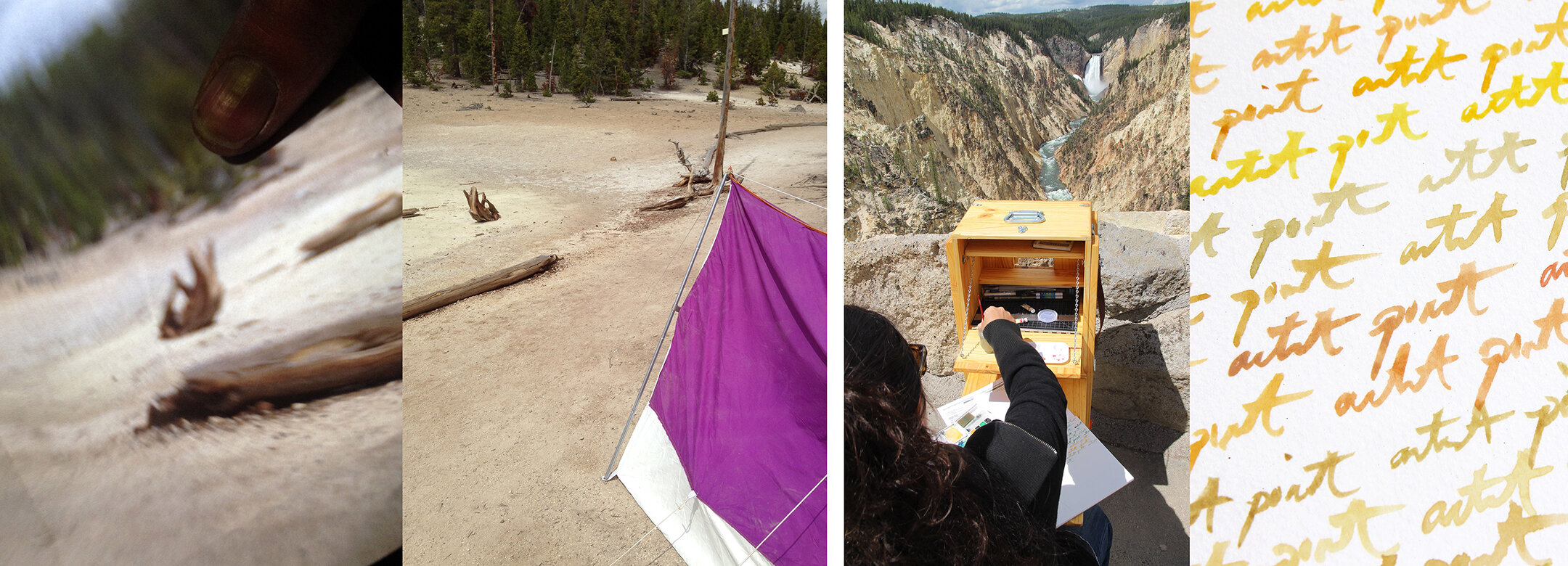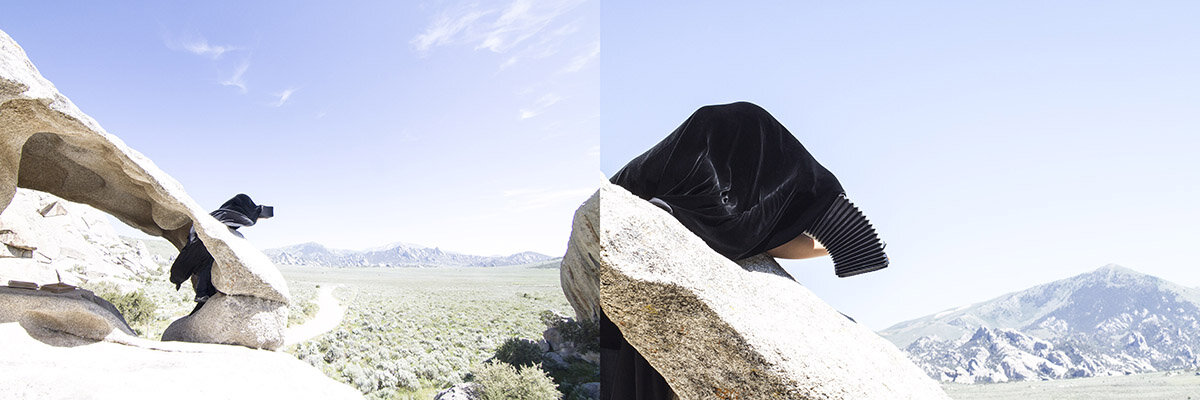



Site #1
Yellowstone National Park, Wyoming
June 13-15, 2016
In a recent acceptance speech for the Pilgrim Award, a Lifetime Achievement award presented by the Science Fiction Research Association for SF scholarship, Donna Haraway states, “It matters what matters we use to think matters with...It matters what stories make worlds, what worlds make stories.” Following her path we wonder about ways to make wonder. We wonder about worlds, and art: about abstracting the same old story that gets told and that makes the same world. Because it matters how artist’s articulate art. It matters to matters of justice. It matters how art enacts action. Transmutation matters: It matters how art changes the states of things, paper, water, pigment, microbes, air, people, imagination.
And so on June 16, to launch “Imagine Our Parks” we made an intervention on art making worlds in Yellowstone National Park: Writing the words Artist Point over and over in watercolour pigment to match hues seen and not seen while sitting at a custom-built portable field desk amongst tourists making and taking photographs. Hiking into a nearby spot: Sinkholes between Lilly Pad Lake and Clear Lake. Setting up a portable camera obscura pup tent, cutting a hole for a lens to look through, catching the fleeting image on a piece of paper. The world, upside down, backwards, textured to the paper catching the light. Creating transmutations through “cosmological performances” (Haraway 2013).
Site #2
City of Rocks National Reserve, Idaho
June 17-19, 2016
City of Rocks: Cosmological performances*
Both a popular climbing crag in the present and a part of the historical California Trail used to move bodies west, City of Rocks is located on Shoshone-Bannock and other Indigenous territories. Over the past few hundred years the area has been claimed by Mexico, Canada and the USA. At present, it exists as a National Reserve in the United States -- a symbolic space monumentalized in the photographic record and foundational to mythologies and realities of colonization and nation building in the USA.
Photographs are connected to ideas of truth and order in archives. They are central to the histories we tell and that are told to us. But what of those images that are primarily out of order? Of archives that misbehave, that undo the monumentality of history and operate both inside and outside the ordinary?
In 1868, Timothy O’Sullivan took a photograph at City of Rocks. Reviewing this well-worn story we learn that he was working with the Geological Exploration of the Fortieth Parallel to photograph the West and attract settlers. O’Sullivan’s images have always been and continue to be widely circulated. They are accessioned into the archives of the War Department (a reminder of their operation not only in nostalgic stories of national identity but in the ongoing war against those that don’t fit the idea of nation-building) and now circulated on the National Parks Service site to talk about the history of the place.
The image promises to be legible; an archival record, “City of Rocks,” a stereoscopic view of a hilly background, groups of rock forms in the midground and foreground vegetation. The stereoscope, the first 3D technology creates an illusion of depth from two offset images placed side by side. The two dimensional images are combined in the brain and three-dimensional depth is perceived. “City of Rocks” shows a foreground interrupted by a regular pattern that spreads across about ⅓ of each of the two images. The pattern appears to be either emulsion damage creating a regular form (possibly from reticulation, which comes from shocking the emulsion during development or, the imprint or residue from interleaving between photographs sticking to the image), leaving its texture on the surface of the photograph. In digital space, where we encounter the image, it’s impossible to know for sure. Despite the acceptance of O’Sullivan’s story of the places he saw, how does this negative work within and against the history of photography and the expectations of a place?
The emulsion of the archival photograph is badly damaged, creating an almost totally incomprehensible image, and the breath camera is harnessed as a method to encounter the image. Attempting to re-enact O’Sullivan’s image is an impossible feat. The image is not only not in the past, but as it never was. The addition imprinted into the archive (the damage) makes it something that never was, despite being held up as evidence of how things were. No longer a photographic record, now it is a montage, a collage, a readymade. How can we use this archive to better understand this place as more complex than photographs and histories tell it? How can we harness the impossibility of the view and make our own impossible views?
And so on the top of large sculpted boulders, pinnacles, and ledges, we looked at igneous and granite rock formations. Shrouded in an oversized 3 foot x 9 foot darkcloth and with howling wind blowing the fabric out of control, the more than ordinary emerges: small cracks, joints in rocks, pools of water: all that lives within the ordinary. In geological terms, we examine contraction, extensional tectonics, and expansion as they become visible through the lens of the camera. As we examine, things slip away. Through the movement of ourselves working the bellows, as well as being pushed about by wind, images are ever-changing, hovering beyond phenomena.
As a provocation towards ways of thinking about histories that are and will be including the histories of “public art” and “public lands”:
This is photography that resists an impulse towards fixing chemistry on a substrate.
This is performance as lenses and light and image, movement and change.
This is the sun overhead, and we’re on a ledge together, in pursuit of the image, attracted to its high-key reflection in pools. Rippling light is hovering through the lens, inverting a world we expect, and all the while, the wind refuses the fixed image. We are pushed away from focus: An ever-changing archive of surprise images upside down and backwards.
*Cosmological performances: We borrow from Donna Haraway’s idea of “cosmological performances” and bend it for own making and thinking practices.
Site #3
Oregon Desert Trail (Southeast OR)
June 22-24, 2016
Pup Tent Camera Obscura installed in a "Burned Landscape" in the Oregon Desert Trail (Bureau of Lands Management Land)
Pup Tent Camera Obscura is a repurposed 1970s/80s McKinley A-frame tent modified to be completely dark inside and fitted with a set of simple lenses on one end. Inside the room the lens projects the world outside onto the walls of the room and onto hand-held paper. The darkened tent becomes a temporary site for one or two people. A moving image on the tent wall stirs in the breeze and a proto-filmic experience emerges.
Video elements by Sharon Mansur
Site #4
Jedediah Smith Redwood State Park, California
June 27-29, 2016
This performance took place on top of our campsite bear locker in Jedediah Smith Redwood State Park. Video footage accumulated throughout our journey was projected from within the bear locker during the performance.
Timothy O'Sullivan
Source: War Department. Office of the Chief of Engineers. U.S. Geological Exploration of the Fortieth Parallel. (1867 - 1881)
